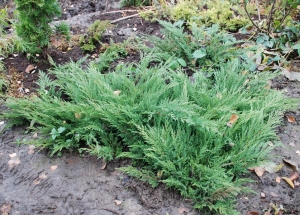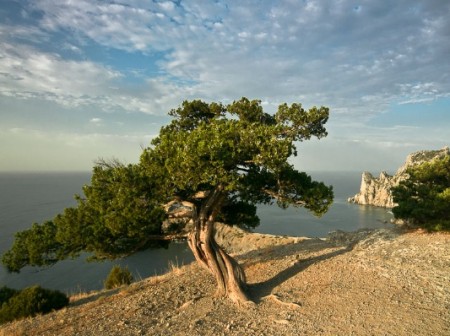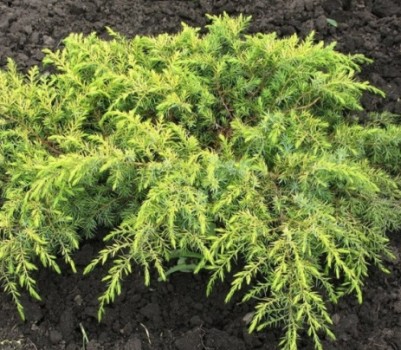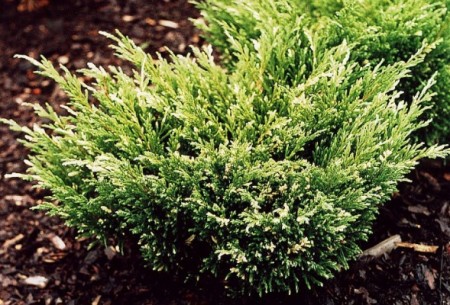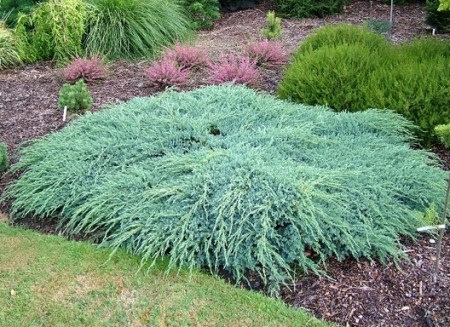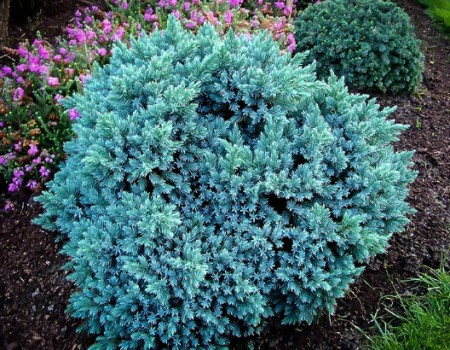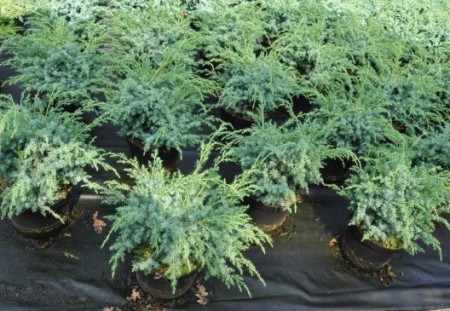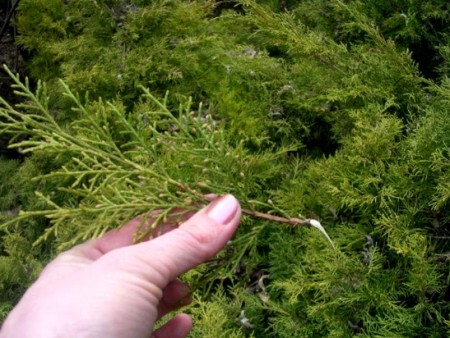Gardens of juniper plantations are generally considered clean. This representative of cypresses loves only environmentally friendly places. Rarely what grade is suitable for a gassed city. And they have more than 70 junipers. Depending on the size of your site, you can choose a certain kind of heather tree. Juniper will emphasize the richness and originality of the garden plot. For successful growth and reproduction of varieties you need to know some secrets. We'll talk about them below.
Content
Juniper species and varieties
Juniper is a light-loving and vital tree. It is not afraid of drought, it is adapted to growing in regions with a warm, moderate and cold climate. This shrub is especially revered by gardeners. Some varieties are very convenient to care for, and do not need a cropping crown. For individual varieties, you can create bizarre shapes and outlines. Everything will be jealous of the chosen variety. The junipers distinguish the following species:
- Juniper is common;
- Juniper is horizontal;
- Red cedar;
- Juniper of Dahur;
- Juniperus Cossack;
- Juniper is Chinese;
- Juniper recumbent;
- Juniper siberian;
- Juniper rocky;
- Juniper scaly.
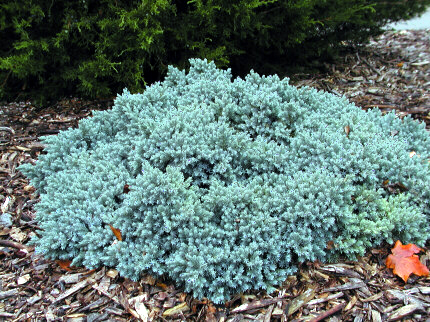
Among the listed varieties are the most frost-resistant varieties, which are suitable for cultivation in domestic latitudes. There are also other types:
- Juniperus Turkestan;
- Juniper leaning;
- Juniper Jaravshan;
- Juniperus red.
These juniper variations are suitable for growing in warmer climates with a moderate temperature.
For now, gardeners distinguish such types of conifer as juniper, horizontal, scaly, Chinese.
juniper common
The native land of the natural habitat of juniper is considered to be forests of Europe and North Asia. In Russia this species of heather tree grows from the Caucasus to the forests of the northeast. If you decide to choose this tree for planting on your site, then know that in addition to an attractive appearance it has a lot of useful properties. Inhaling the pairs of this magnificent tree, you will regain your strength and get rid of fatigue. And if you fall in the fall to collect cones and needles, then with the help of cooked infusions can be cured of pulmonary, cold, vascular diseases. Also, by this autumn, small blue berries grow. They exude a pleasant fragrance, and if you assemble them, you can cook jam.
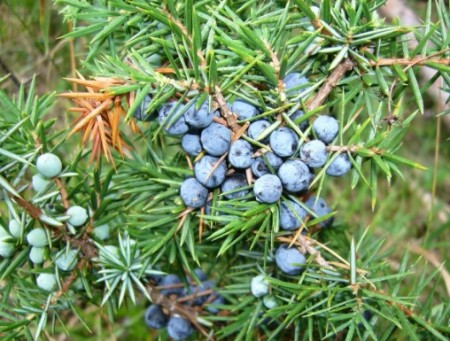
In height, the common juniper reaches from 2 to 10, and even 12 meters. The crown of this tree is dense, needle-like. Has an oval and conical shape. The trunk of the tree is fibrous. A variety of common juniper prefers humidified soil. The lifespan of the heather tree is more than 200 years.
The most popular varieties for domestic farming are:
- Gold Cohn - changes its color range throughout the year. Spring begins with a bright yellow color, by autumn the shoots turn yellow-green, and for the winter they get a golden brown color. A tree at 10 years of age does not exceed 2 meters. It grows 10 cm per year;
- Mayer - has a columnar shape, the maximum height is 4 m, the color is green-blue;
- Pendula is an unusual weeping variety, up to 5 m high;
- Ehinoformis - has a lush crown of a spherical shape. In height, usually no more than 5 m;
- Nana Aurea is a creeping variety. The height, as a rule, is not more than 50 cm. The color of the crown is from bright golden to yellow-brown.
juniper horizontal
Juniper horizontal is a dwarf creeping variety, reminiscent of juniper Cossack. The height of the adult bush is from 10 to 50 cm. The crown grows in width. Under favorable conditions (sufficient lighting and nutrient moisture), the tree spreads over the soil to 2 m. It can be planted near water bodies, its wood is resistant to water contacts.
Plants of this type are windproof and do not require special soil composition. For their favorable existence, a sufficiently moist soil. In the absence of such a shrub easily adapts to other soils.
Among the many varieties of lovers of an ever-green plant, it is customary to single out:
- Narrow juniper horizontal "Variegata" - this bush differs in its coloring. Among the constant green-blue hue there are whitish patches on the shoots. The height of juniper does not exceed 60 cm. In width up to 3 m;
- Juniper is horizontal "Blue Chip" - the height of the bush is no more than 30 cm, and the width is up to 1.5 m. Needle branches have a gray-blue hue in the summer and brownish in the late autumn. Moreover, on the bush are formed pine cones. In color they are close to black. Ogorodniki choose this variety for resistance to increased gas contamination, undemanding conditions of existence and a powerful root system. The latter is particularly convenient in soil conservation from erosion;
- Juniper is horizontal "Andorra Compact" - a small tree in height not more than 40 cm. Soft pillow-shaped crown in width is up to 1 m. It grows evenly slowly. The small twigs first grow from the center of the bush diagonally. Then horizontally. For a year the tree grows only 1 cm. Needles have a greenish-ashy tinge. At the onset of cold weather, the crown becomes purple. On the shoots in autumn there are blue pine cones. The advantage of this variety is that it can grow not only in sunlit areas, but also in partial shade.
juniper scaly
Juniper scaly is a winter-hardy variety. It is adapted for cultivation in the Russian territory. This tree has a lush spreading crone and a hard trunk. As for the needles, it has a bluish tinge, which can disappear in the case of a strong darkening of the bush. During the whole year the juniper has a single color.
In height, the plant reaches 1.5 m. In the second year, after its planting on the tree, reddish shishkyagods form. As they mature, they become black.
Among the decorative varieties for landscape design distinguish:
- Juniperus Blue Carpet - one of the unpretentious varieties of soil selection. For his planting is suitable land with a moderate amount of light and sufficient humidity. Water stagnation should be avoided. This variety grows very quickly. Already at the age of 10 the tree reaches a mark of 0.6 m. The only thing that the crown of the Blue Carpet fears is the snowy debris. Under their weight, branches can break off. Therefore, timely release the tree from snow surpluses.
This decorative grade is suitable for decorating an alpine hill, a rocky garden, for growing in containers and further placement on roofs and balconies;
- Juniper Blue Star - this shrub, on the contrary, is characterized by slow growth. At the age of 10, its height is only 0.4-0.5 m, width 1-1.2 m. In a year it adds 2-3 cm in height and 6 cm in diameter. The bush has a neat compact shape, needle-shaped short needles (0.5-1 cm). The selection of soils is not fussy. Preferred are lighted areas, but can also grow in shaded areas. Has increased frost resistance. The ideal solution is the placement in rock gardens, in curbs, rocky garden;
- Juniper Meyeri - one of the favorite varieties of gardeners. This shrub forms a creeping shape with hanging branches. It grows on well-fertilized soils. Every year it adds in height of 20 cm. In the adult period (10 years) its height is about 2.5 m and the width of the crown is 1.5 m.
The tree is ideal for creating topiary. It is easy to be cut and care. The color of the needles is blue. It will stand out among coniferous plantations, alpine hills or near water bodies;
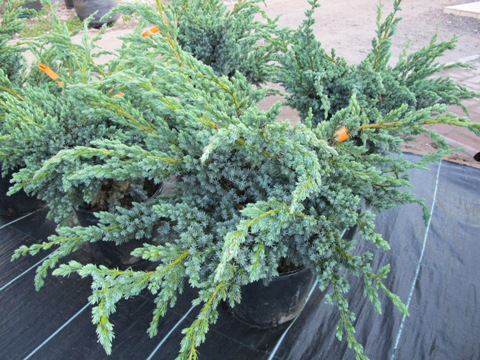
- Juniper Holger - this unusual shrub will be allocated in the garden area due to the unusual coloring of the needles. Sprawling branches combine shades of a silvery-green hue, their ends are terminated with salad yellow needle brushes. Despite its scenery, this juniper variety is resistant to frost. Can grow even in shaded areas, but privilege gives sunlight. Compositions of Holger juniper are perfect for decorating rockeries, terraces, green flower beds.

juniper chinese
The birthplace of juniper Chinese is Japan, China, Korea. Hence the name. This tree can grow both in arid regions and in places with high humidity. Prefers calcareous and stony soils.
The first years of life the plant grows slowly, then its growth intensifies. Depending on the variety, its height can be 8-10 m. In natural conditions, the juniper grows to 25 m. The needles of the tree are green. In some varieties can contain a spray of cream, yellow shades. As a rule, the Chinese juniper has a pyramidal crown, a columnar or a columnar shape. In some of its species branches can spread along the ground.
Needles of this plant can be acicular and scaly. Also, depending on the variety, the cones have different shapes: oval, globular, angular. Content - their seeds, in an amount of 2 to 4 pieces. The most common varieties are:
- Juniper Juniper Strict;
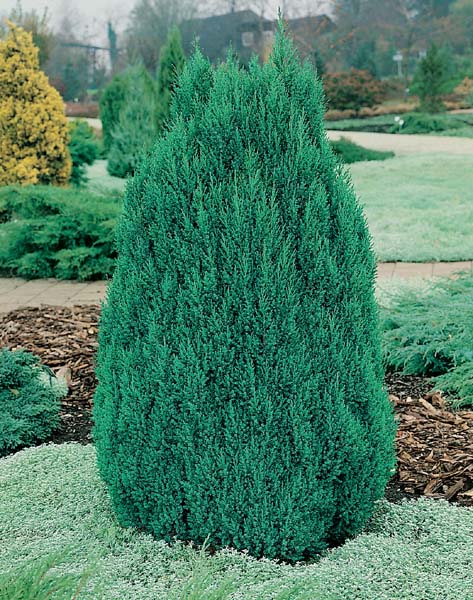
- Juniperus Blue Alps;
- Juniper monarch;
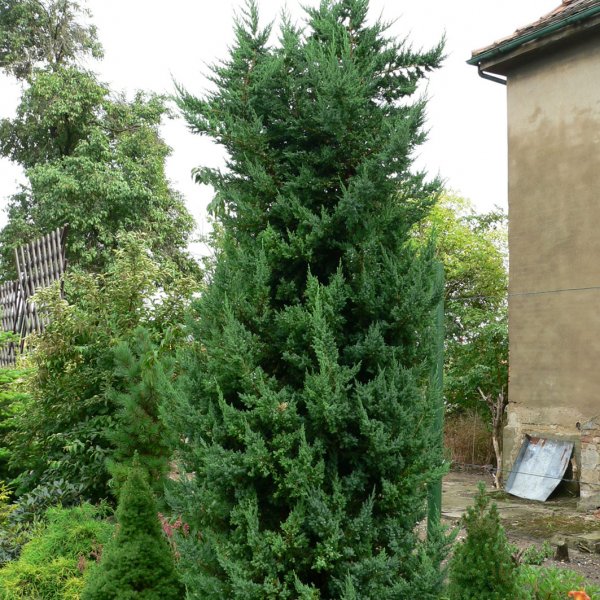
- Juniperus Plumoza Aurea;
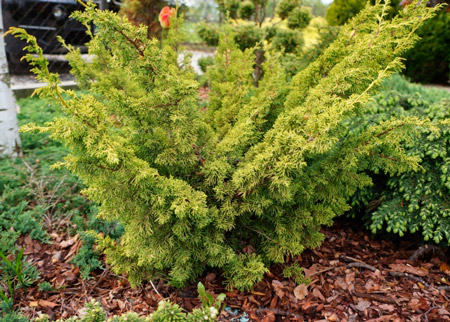
- Juniperus Curivao Gold.
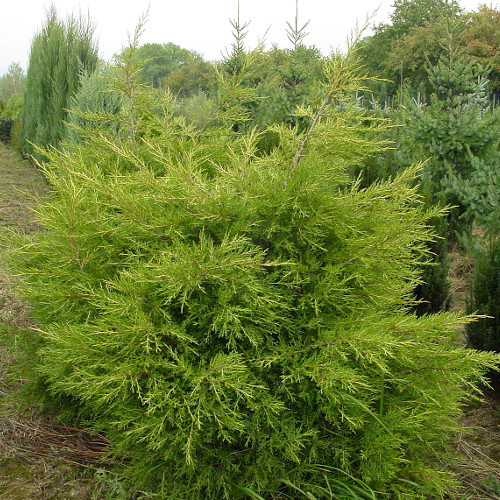
Juniper propagation
By the method of reproduction, juniper is similar to thuja. Conditionally, this process can be divided into the following methods:
- Cultivation from seeds;
- Cutting;
- Wrapping;
- Division of the bush.
how to plant a juniper:
The simplest way is to seminal. Immediately after the fruit of the juniper has ripened, berries need to be harvested. Separate the shell. Take out the seeds and drop them into a pot of forest land. You can mix purchased land with a garden (50:50).

At the bottom must necessarily be drainage holes. If you plant the seeds in boxes, then the bottom is covered with a film. Perforate the film on the bottom of the plate.
The fact is that seeds before splitting and germination go a long way. They need this process for at least a year. And this is with all the well-being of the process. Sometimes this can take 2-3 years. To not wait for a seed germ for so long, they need to be scarified. That is, deliberately damage their shell. This is done in several ways. You can soak the seeds for half an hour in hydrochloric acid. And you can rub them on a grater or sandpaper (within reasonable limits).
Consider that seeds should be taken "with a margin". They do not all come up, so sow them in rows of several pieces. After your landing tank is filled, it should be buried in the ground on the site. The box or the pot must not be immersed entirely in the ground. Elevate it 2-3 cm above the level of the soil layer. This is done in the fall, right after you took the seeds. Boxes are left in the street until the onset of spring. Then they can be brought into the house or transferred to a greenhouse.
After emergence of the shoots, it is necessary to plant in pots with a smaller diameter, but all with the same drainage holes. Now the individual pots are planted on a site with sufficient sunlight and are left so for 2-3 years. Then transplanted into the open ground. A landing pit is dug out, fertilizer is laid in it. After instillation of the plant, watered.
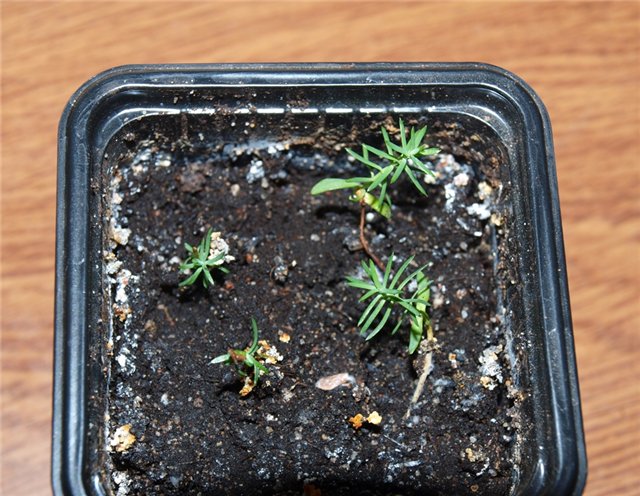
To preserve the variety, reproduction by cuttings.To do this, cut the branches (cuttings) with pieces of bark. Then put them in a bowl with earth and fertilizer, abundantly watered and covered with a film. The film is needed to maintain moisture. So, the cutting should be within a year in conditions with high humidity, so that its root system develops and takes root. After the stalk is ready for transplantation (2-3 years), prepare a pit for planting.
In the hole 10-15 cm is lined with a layer of fertilizer and maternal drainage, or needles. To them a strong stalk is set and watered.
Reproduction by way of a thinning conduct mainly for creeping varieties of juniper. To do this, in April young shoots are slightly incised or scratched and placed in the grooves of the earth. To the ground they are attached with the help of wooden slingshots. The ends are tied up to the pegs. Above the layer can be sprinkled with peat and sand. The next spring they are separated from the mother's shoot and transplanted into a permanent place.
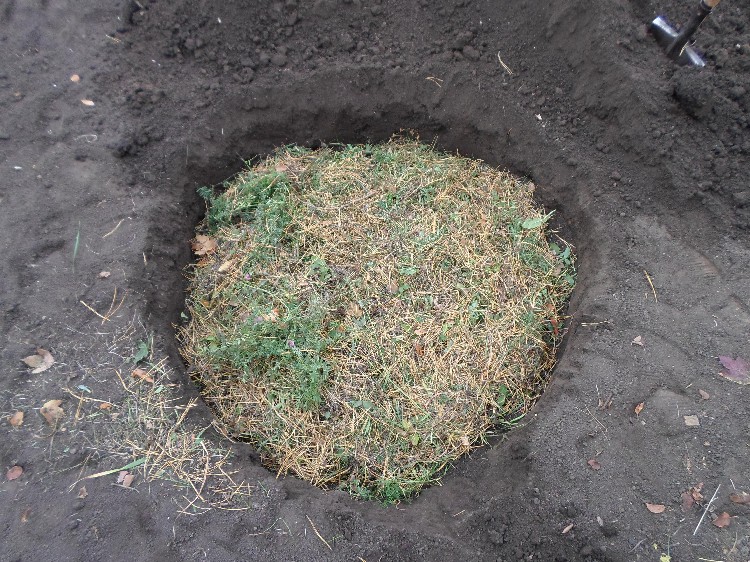
Method of reproduction separation from the main bush suitable for young plants. In May, make a plentiful hilling of the mother bush. Thus, the lower branches will form the subordinate roots. During this period, make sure that the soil does not dry out. In the end of August dig out a bush. Separate the branches with the root shoots. Put them in a container with a drainage hole (into the ground taken from the garden). Pre-hold the sprouts for 24 hours in a glass of water, diluted with a spoonful of honey.
After the plant is planted in a container, it is buried with a pot into the ground for the winter. The shoot is warmed with hay or foliar humus. Top cover with paper bags or plastic cuts from bottles.
The next spring you can transplant the juniper to a permanent place in the ground.
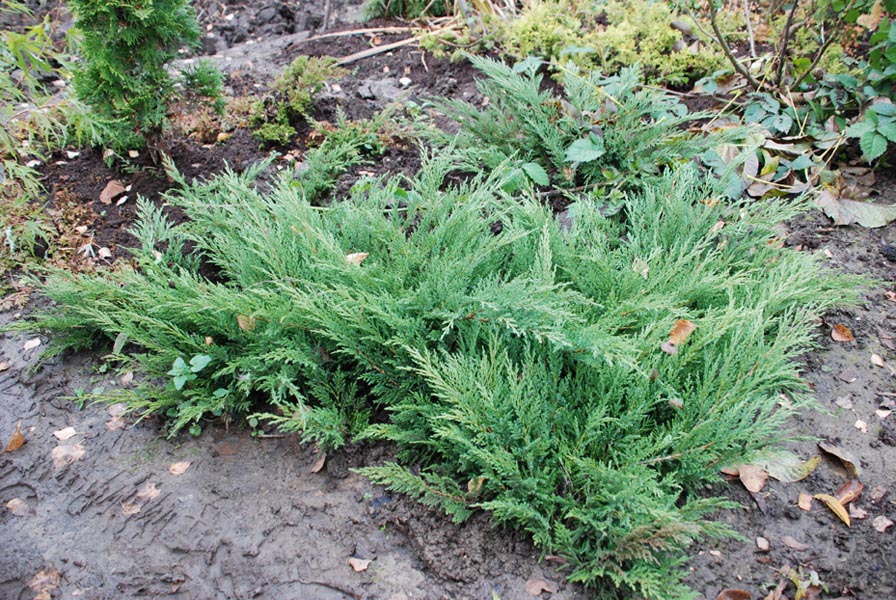
In conclusion, it should be noted that juniper is a universal plant. Having provided him with proper care during the first three years, you will enjoy his beautiful views, only occasionally adjusting needles at your own discretion. Have a successful landing!


